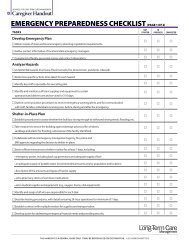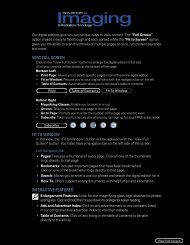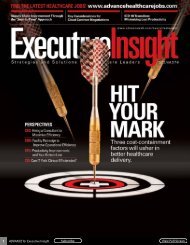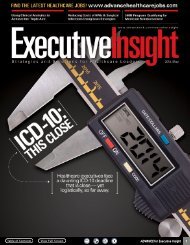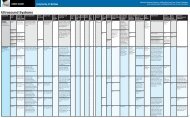ADVANCE for Executive Insight 1 ADVANCE for Executive Insight
ADVANCE for Executive Insight 1 ADVANCE for Executive Insight
ADVANCE for Executive Insight 1 ADVANCE for Executive Insight
- No tags were found...
Create successful ePaper yourself
Turn your PDF publications into a flip-book with our unique Google optimized e-Paper software.
telemedicine<br />
nurses can monitor the various ICUs remotely.<br />
Since implementing this program, Mercy’s mortality<br />
rate, hospital length of stay and ICU length<br />
of stay have dropped by 20-30%.<br />
In addition to a tele-ICU, Mercy also has a<br />
telestroke program in which we use mobile<br />
telemedicine carts in each of our emergency<br />
departments (ED). If a stroke patient comes to<br />
the ED, we can move the cart to the patient’s<br />
bedside and a specialist can begin assessing and<br />
treating the patient right away. This not only<br />
gets expert care to the patient faster—a critical<br />
element in limiting the potential damage<br />
caused by a stroke—it also reduces the disruption<br />
to the patient because he or she does not<br />
need to be moved.<br />
Helping More Than Just Patients<br />
In addition to enhancing patient care, telemedicine<br />
can bolster clinician recruitment and retention<br />
ef<strong>for</strong>ts. For example, it can be challenging<br />
to recruit a highly credentialed specialist to<br />
work in a small hospital, and even if you can get<br />
an individual to come, you may only be able to<br />
af<strong>for</strong>d one such person. With no back-up, the<br />
specialist would need to be on-call year-round<br />
without any breaks. This punishing schedule<br />
impacts quality of life and leads to high physician<br />
turnover.<br />
Through telemedicine, Mercy is able to have<br />
back-up support <strong>for</strong> all specialists, enabling the<br />
organization to offer specialized care at any time<br />
and at any facility. We can also ensure our physicians<br />
maintain balance in their lives, increasing<br />
both satisfaction and retention.<br />
Telemedicine also fosters continuity of care.<br />
For example, within the last year in one of our<br />
Lead Like A Rock Star:<br />
Rock Solid Leadership,<br />
Communication, and Collaboration<br />
August 28-30, 2013 • Myrtle Beach, SC<br />
The South Carolina Medical Group Management Association<br />
(SCMGMA) will host its annual conference "Lead Like A Rock Star:<br />
Rock Solid Leadership, Communication and Collaboration", at the<br />
Hilton Myrtle Beach Resort and Convention Center, Myrtle Beach,<br />
South Carolina. The event will feature presentations of interest to<br />
medical practice managers, hospital VPs and directors, and physicians.<br />
Topics include futuristic medicine, the Af<strong>for</strong>dable Care Act,<br />
Medicare E and M Coding, process improvement, patient<br />
satisfaction, as well as a healthcare panel discussion.<br />
Those interested in attending or exhibiting may visit our website<br />
at www.scmgma.com or contact<br />
Cindy Ott, <strong>Executive</strong> Director, at 803-387-7864 <strong>for</strong> more in<strong>for</strong>mation.<br />
Being open to<br />
change is the key<br />
to getting the<br />
most out of this<br />
technology. If<br />
you can imagine<br />
it, it’s probably<br />
possible, which is<br />
what makes using<br />
telemedicine<br />
so exciting and<br />
rewarding.<br />
On the Web<br />
For related content, enter<br />
“Telemedicine” in the<br />
keyword search box at<br />
www.advanceweb.com/<br />
executiveinsight<br />
facilities, we had a pediatric neurologist resign<br />
and there was no backup in place to cover his patients.<br />
Without telemedicine, we would’ve been<br />
<strong>for</strong>ced to shut down the service until we found<br />
a replacement. Instead, we refitted one of our<br />
stroke telemedicine carts to support pediatric<br />
neurology and had the service back up and running<br />
in a week.<br />
Overcoming Roadblocks<br />
One of the biggest challenges Mercy had when<br />
launching the telemedicine program was physician<br />
resistance. Some physicians initially struggled<br />
to accept this technology as an appropriate<br />
way to assess patients and ensure safe care. We<br />
found the key to overcoming hesitation was to<br />
identify physician champions and enlist their assistance<br />
in getting others on board.<br />
We also learned that a physician needs to experience<br />
telemedicine firsthand to fully appreciate<br />
it. The equipment has a high-definition, color<br />
camera that can zoom in to an area, allowing a<br />
physician to conduct a thorough assessment,<br />
examine wounds, read an IV bag and so on. By<br />
interacting with the equipment, physicians can<br />
better visualize how the technology enhances<br />
patient care.<br />
Getting Started<br />
There is no established blueprint <strong>for</strong> launching<br />
a telemedicine program. The approach we took<br />
was to first research current trends in the field,<br />
and since the technology is evolving rapidly, it’s<br />
important to keep attuned to what’s happening<br />
in the market. We also developed a strategic plan<br />
that outlined short-term and long-term goals.<br />
After that, we dove into the work, pilot testing<br />
different applications to see what was most beneficial<br />
<strong>for</strong> our organization.<br />
Even though Mercy Health has had a telemedicine<br />
program since 2006, we feel we’ve<br />
just scratched the surface of the technology’s<br />
potential. We are constantly finding ways to<br />
incorporate telemedicine into patient care. We<br />
have 72 projects under way that are integrating<br />
the technology into various areas, including<br />
school-based clinics, work site clinics, palliative<br />
care programs and remote home monitoring<br />
programs.<br />
Being open to change is the key to getting the<br />
most out of this technology. If you can imagine<br />
it, it’s probably possible, which is what makes using<br />
telemedicine so exciting and rewarding.<br />
42 <strong>ADVANCE</strong> <strong>for</strong> <strong>Executive</strong> <strong>Insight</strong>



